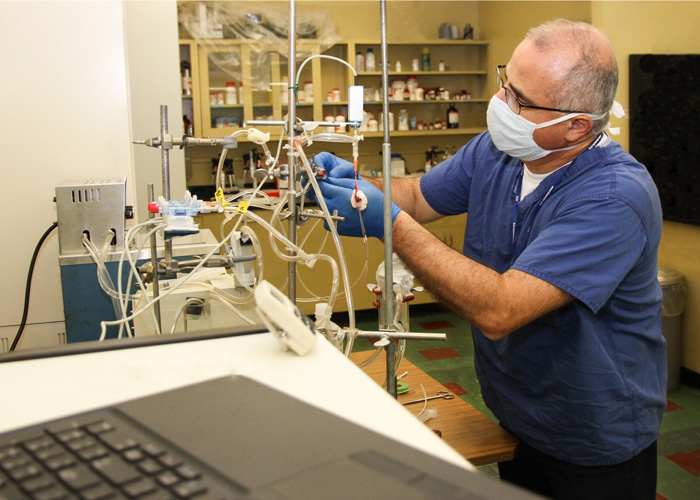Seifert Dissertation Abstract
Experimental and Computational Characterization of Annulus Fibrosus Damage
Dissertation Date: March 11, 2025
The annulus fibrosus (AF) is a thick, multilayered collagenous tissue surrounding the nucleus pulposus within the intervertebral disc (IVD), with each layer consisting of a highly organized matrix of parallel collagen fiber bundles and elastic fibers. This structure enables the AF to resist the complex stress states of normal spinal movements, playing a critical role in maintaining spinal stability. However, repetitive mechanical loading can degrade its structural integrity, leading to altered spinal biomechanics, increased susceptibility to injury, and accelerated degeneration of the IVD. Understanding how mechanical damage accumulates within the AF and its consequences on tissue mechanics is essential for predicting injury risk and informing computational models that simulate AF behavior under physiological conditions. The objective of this dissertation was to experimentally characterize the mechanical and structural degradation of the AF due to cyclic loading and develop a finite element model (FEM) capable of simulating these damage-induced changes.
Aim 1 quantified the elastic, yield, and ultimate properties of healthy AF tissue subjected to uniaxial tension in both the circumferential and axial directions to establish baseline mechanical properties. These tests established a normative dataset of mechanical properties from tissue devoid of age-related degeneration, providing critical reference values for understanding AF mechanics and calibrating computational models. The results demonstrated significant anisotropic mechanical behavior of the AF, with the outer AF exhibiting greater stiffness and strength than the inner AF. Additionally, the study identified a consistent yield point at approximately 75–80% of the ultimate strain, suggesting that tissue damage initiates well before macroscopic failure.
Building upon this baseline, Aim 2 investigated how cyclic loading degrades AF mechanical properties over time. Mechanical property changes were evaluated through a three-step protocol involving pre-damage characterization of dynamic and viscoelastic properties, damage induction using predetermined loading cycles to a specified strain magnitude, and post-damage characterization of the same properties. The results demonstrated that exposure to higher strain magnitudes progressively decreased the dynamic and viscoelastic properties of the AF, while having minimal impact on its ultimate tensile properties. This suggests that repetitive loading affects the AF’s mechanical response under low-strain conditions without compromising its overall structural integrity. These findings provide new insights into the mechanics of healthy and damaged AF tissue, offering a foundational dataset for understanding AF damage accumulation.
To link these measured mechanical changes to structural damage, Aim 3 examined how cyclic loading affects the integrity of collagen and elastic fibers within the AF. Isolated AF specimens were prescribed a set number of loading cycles to a specified strain magnitude. Hematoxylin and eosin (H&E) staining and fluorescent collagen hybridizing peptides (F-CHP) were then used to analyze AF tissue damage by relating structural damage to cyclic loading parameters. The H&E stained tissue revealed cleft formation and collagen fiber uncrimping within the matrix, with the prevalence of these features and cleft size correlating with the applied damage strain magnitude. However, F-CHP staining revealed no significant differences in denatured collagen fibers between damage groups. These findings support the hypothesis that cyclic loading induces irreversible structural changes that compromise the AF’s mechanical properties.
Finally, Aim 4 leveraged these experimental findings to develop a FEM of the AF that incorporated viscoelastic collagen and elastic fibers, allowing for the simulation of both healthy and damaged tissue mechanics. The model was calibrated using the experimental dataset from Aim 2 and validated against independent datasets to ensure accuracy in replicating AF behavior. Damage accumulation was simulated using independent fiber damage functions, enabling the model to capture post-damage mechanical trends. While the model successfully reproduced many aspects of AF mechanics, it underpredicted post-damage stress relaxation and cyclic loading changes, likely due to the absence of fluid interactions within the tissue and a lack of simulated plastic deformation. Despite these limitations, this study marks a critical advancement in computational modeling of AF damage mechanics, as it is the first to verify post-damage mechanical properties against experimental data.
By integrating experimental and computational approaches, this dissertation provides a framework for understanding how repetitive loading influences AF mechanical behavior and structure. The findings have broad implications for spinal biomechanics, injury prevention, and the development of preventative measures aimed at reducing damage accumulation within the AF from repetitive loading. Future studies can build upon this foundational work to further investigate the long-term effects of cyclic loading on AF integrity, refine damage modeling techniques, and enhance the predictive capabilities of FEMs for research and clinical applications.
Return to Dissertation Schedule


